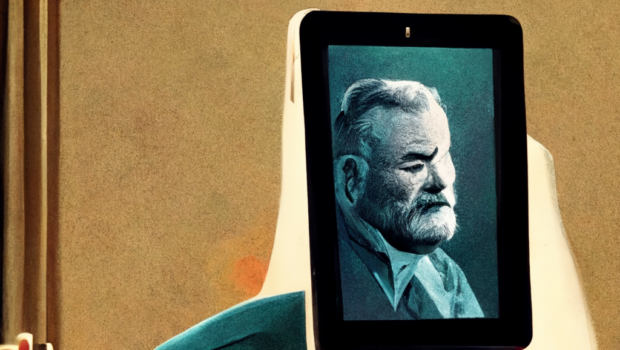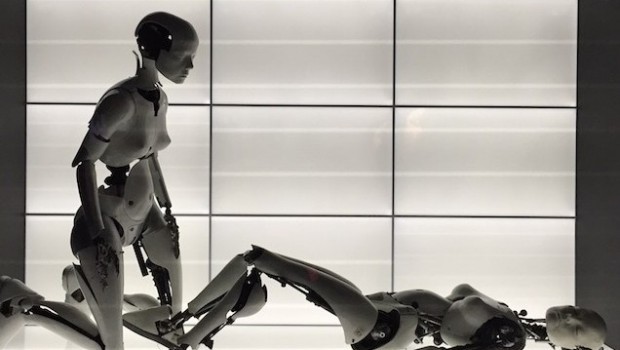AI Helped Me Write This Article
Efraín Villanueva
Twelve years ago, a friend of mine and I were having some beers when we shallowly started discussing the possibilities of artificial intelligence. I pointed out my firm conviction that, sometime in the future, AI would be able to perform and master all intellectual human activities. After all, I argued, these are machines and algorithms that we are purposedly building to replicate human thinking. Hell, we are expecting their computational capacities to reach limits we know our brains will never achieve in their current state.
My friend established a position that, as I saw it, was not only opposite to mine, but unlike that of an admirer of the futuristic vision of Isaac Asimov. AI, he claimed, will certainly be able to analyze data and provide us with solutions to real-life problems, such as renewable energy or environment-friendly materials –before AI, we had been discussing whether cities around the world should reduce public illumination to save up energy. He did not think, however, that an algorithm could engage in any artistic capacity, like writing a novel. At most, he continued, computers could learn grammar and how to put words together in patterns and styles that do make sense, but their work will be just the result of a machine imitating input texts written by humans. Creative writing requires that something that only humans possess, he concluded.
The colors on the previous paragraphs are not glitches on your screen. I ran them both, unedited, through the Hemingway App, an algorithm that judges the readability of a given text. It measures “the lowest education [level] needed to understand your prose”.
Hemingway rated my draft as “OK”, with a readability of 15, and suggested me to aim for 9. (Incidentally, “Ernest Hemingway’s work scores as low 5th grade”.) The sentences in red were very hard to understand, too “dense and complicated”. The app recommended me to edit them. The sentences in green were hard, and I was supposed to “shorten or split” them. In aqua, the adverbs, words that weaken the texts’ readability. “Big words to sound more educated” were marked in purple.
I played along with the app. These paragraphs were drafts and I had to proofread them, anyways. Hemingway seemed pleased with my changes. My text was still “OK”, but its readability improved from 15 to 7, and all highlights disappeared:
Twelve years ago, I had a debate about the possibilities of artificial intelligence. My position was that AI will be able to perform and master all intellectual human activities. After all, we build these machines and algorithms to replicate human thinking. Even more, we expect them to reach limits we know our brains will never achieve in their current state.
My friend had a different opinion. He acknowledged that AI could help us solve many kind of problems, such as climate change. But he could not envision an algorithm engaging in any artistic endeavor, like writing a novel. AI might learn grammar and how to put words together in patterns and styles that do make sense. But their works will be the result of a machine imitating input texts that humans wrote. Creative writing requires that something that only humans have, he concluded.
Artificial Intelligence (Al) is a computer program that can “learn” and create its own content. This includes things like writing articles, creating artwork, and even solving complex math problems. Now that I have explained what Al is, let’s talk about why it’s so important in the art world. Because I know you are curious about this…
Creative writing and art are things I enjoy doing in my spare time, and they are things that take a lot of time and energy to create. They often require using many different methods or coming up with new ideas. So how exactly does Al help artists in their creative process? Well, the first thing it does is make the process of making art and writing more efficient. In other words, it helps you to spend less time working and more time actually creating something beautiful and meaningful.
What does this mean in practical terms? Let’s say you write a short story and are stuck for ideas. You could use an Al to help you with this process. For example, you could upload a short story into an algorithm and then let it analyze it and make suggestions based on all the stories that have already been written. That way you would know a good place to start your story from.
The second thing that Al does is provide helpful feedback on your work. This is useful because it provides you with both constructive criticism and positive encouragement. Feedback is extremely important in the creative process because it helps you to improve your work and ensure that it is as high-quality as possible. Al can do this for you by using human language analysis and machine learning to recognize patterns in your writing or artwork. Based on this information, the Al can determine whether your work is good or bad and provide you with suggestions for improvement. Like the Hemingway App, but with specific recommendations.
What is your impression of the previous four paragraphs? Do they follow the topic of this article? I think they do. I did not write them, though. Jenni did. Jenni is an AI trained for writing.
This is how it worked: I gave Jenni this article’s title and a summary: “AI and its skills on creative writing and art.” After she wrote the first sentence, she continued building the article sentence by sentence. I could either accept them or ask for new ones, guiding the direction of the text. I also kept her away from drifting, like when she wanted to include how Amazon uses AI to write more effective product descriptions. As I worked with (for?) her, it hit me: I became Jenni’s inner voice. The one that all of us human writers have.
By the end of the first paragraph, I considered that Jenni was becoming too abstract. So, I wrote my first words: What does this mean in practical terms? The way she managed my intervention on her text stunned me. She answered my question without forgetting to finish the idea of her “first thing” before starting her second point. Unfortunately, I had a limitation of words on the free version of Jenni that I used. I couldn’t help her continue. So, I concluded the article: “Like the Hemingway App, but with specific recommendations.”
Jenni is not trained for creative writing. But Sudowrite is.
I asked it to compose a poem about love. Unlike Jenni, Sudowrite requires at least two seed lines. I browsed my digital notes for quotes that me and wife blur out from time to time anc consider save-worthy. I picked one and turned it into two verses: “it’s only cheating / when you fall in love.” The algorithm wrote this:
A Beautiful Life:
it’s only cheating / when you fall in love / with the wrong person / and it’s beautiful / when you fall in love with the right person / love is a river, a river of time, but it’s not an ocean / a river has no waves / it twists and bends, but it always flows / like a river, that is –never still / love is a beautiful life / it’s beautiful – and it’s only cheating / when you fall in love with the wrong person
The poem is cheesy, as if written by a broken-hearted teenager. But it is easy to appreciate Sudowrite’s writing skills. I did wonder why the AI went in such a corny direction. Was it because it had only learned from similar texts about love? Was it because, additionally to my request for a love poem, one of the verses I put in also included the concept of love (love + love = corniness)? Or was it love + love + cheating = corniness? I cannot answer these questions. At least not without looking at Sudowrite’s algorithm.
I decided to try a new test: same lines, but with death as the topic:
The Grave
it’s only cheating / when you fall in love / with the bodies of men
it’s only cheating / when you take a vow to end life / with the same word you used to start it / it’s only cheating / when you say goodbye to your children in death, like a merciful priest, then go find yourself another act of love / It doesn’t matter how long you live / it doesn’t matter how big your house is / it doesn’t matter how much you have / It doesn’t matter who you are / It doesn’t matter what you do / When death comes for you
Pay attention to how the third verse incorporated the new topic. A demonstration of how effective a literary algorithm can be. After witnessing Sudowrite’s ability to create poems, I was curious about its prose skills. Since we have been talking about Hemingway, I fed Sudowrite with the first paragraphs of one of his most read novels, The Old Man and The Sea:
He was an old man who fished alone in a skiff in the Gulf Stream and he had gone eighty-four days now without taking a fish. In the first forty days a boy had been with him. But after forty days without a fish the boy’s parents had told him that the old man was now definitely and finally salao, which is the worst form of unlucky, and the boy had gone at their orders in another boat which caught three good fish the first week. It made the boy sad to see the old man come in each day with his skiff empty and he always went down to help him carry either the coiled lines or the gaff and harpoon and the sail that was furled around the mast. The sail was patched with flour sacks and, furled, it looked like the flag of permanent defeat.
The old man was thin and gaunt with deep wrinkles in the back of his neck. The brown blotches of the benevolent skin cancer the sun brings from its reflection on the tropic sea were on his cheeks. The blotches ran well down the sides of his face and his hands had the deep-creased scars from handling heavy fish on the cords. But none of these scars were fresh. They were as old as erosions in a fishless desert.
Everything about him was old except his eyes and they were the same color as the sea and were cheerful and undefeated.
“Santiago,” the boy said to him as they climbed the bank from where the skiff was hauled up. “I could go with you again. We’ve made some money.”
The old man had taught the boy to fish and the boy loved him.
“No,” the old man said. “You’re with a lucky boat. Stay with them.”
“But remember how you went eighty-seven days without fish and then we caught big ones every day for three weeks.”
I then asked Sudowrite to continue the story:
“That was different.”
The boy smiled. The old man was stubborn. He was always stubborn. “Maybe this one will be different,” he said.
“Maybe,” the old man said. He had made provision for the boy before they left in his sea chest and he had given him a hundred pesos and he had taken the money out of that chest.
The boy climbed into the old man’s skiff and they sailed off.
“What if you catch a big one?” the boy asked.
“I won’t keep it,” the old man said. “I’ll cut its head off. I don’t like to have things a long time.” He never talked about himself.
Look at the rough attitude and direct words of the old man. It does not get more Hemingway-esque than that. If Hemingway wanted to –I doubt it–, he could’ve asked Sudowrite to help him describe the character of the boy in any sensorial level:
Sight: The boy’s hair is blond, his skin smooth and pale, like the moon half-shrouded by clouds. He is tall and strong for his age, and his eyes shine like polished pennies.
Smell: The boy smells of sweat and fish and brine, like he has been in the sea.
Sound: The boy’s laugh carries across the water like a foghorn. It’s bright and cheerful, like singing birds.
Taste: The boy has no taste left of fish. He couldn’t even eat it now. He is full of surprises, fun and light-hearted. Not bitter or salty like the sea.
Touch: The boy’s hands are calloused from pulling on lines and unbaiting hooks. His teeth are often chattering from the cold.
Even a metaphorical description of the character: The boy was as fragile as a collie and as muscular as a tuna, with great golden eyes that glowed like yellow lanterns and a rash like a constellation of white stars.
Comparing the three apps that I reviewed for this article, it becomes evident that the Hemingway App is quite simple. It implements the Automated Readability Index, a formula designed when electric typewriters were still a thing. It can identify grammar issues, but it does not provide you specific suggestions on how to correct them. It cannot detect misspellings. More importantly, the app does not understand the topic of the text. You could mix paragraphs from different subjects, and it wouldn’t notice. With The Hemingway App, you, the writer, are still responsible for editing your text.
I ran all the paragraphs that I wrote through The Hemingway App. On section 2, for example, I scored a readability of 4 even before I made any edits. I only had to correct 2 very hard sentences, 4 hard sentences, 1 adverb, and 1 use of passive voice. The more I wrote for this article the better my results got. Was this the product of my writing skills? Would I have caught these mistakes during my regular review process even without the help of an app? Or did the app have such an immediate effect that it already conditioned my writing? Who knows.
The Hemingway App is not AI, but Jenni is. However, she cannot do much without human intervention. Once she wrote the first line, I was with her along the ride. At most, this was a collaborative work. I would argue that Jenni’s true achievement was her ability to understand the article’s subject and write accordingly. She wrote the sentences. She proposed a path. I became an instrument for her work.
Sudowrite is the one taking all my praises. I could have asked it to choose a variety of tones to continue Hemingway’s story: ominous, fantastical, fast-paced, upbeat, authoritative, conflicted, romantic and sensual. Instead, I selected Auto Mode, which works like the autocomplete feature of our smartphones, trying to predict the most likely word we’ll use next. Sudowrite does that on steroids. It follows GPT-3, a language model that, when “fed an enormous amount of text, [adjusts] its billions of initially randomized mathematical parameters until, when presented with new text, it does a pretty good job of predicting what words come next.” You can tell why Sudowrite’s creators describe Auto Mode as “autocomplete plus magic.”
In a 2021 interview, Amit Gupta, one of the founders of Sudowrite stated: “Other artists have had tools like this for a long time. There are really sophisticated tools for visual artists –whether it’s Photoshop or a 3-D tool, there’s all these things that you can apply. People who are using 3-D models aren’t using clay. But writing has been stuck in the past. We’re not using paper and pen, but we’re not much better off than that.” All the algorithms I evaluated prove that writing might be shifting its ways.
There has always been a romantic aura surrounding writing. Many buy into the idea that it cannot be taught, requires excessive talent and, therefore, is for geniuses only. Unlike other disciplines –such as dance, painting, or music– that do not eradicate these concepts but do have a longer and broader tradition of educational programs. As if writing didn’t require mastering and practicing writing techniques. If we believe that we cannot teach humans how to write a novel the logical consequence is that we can’t teach a computer either.
So, can AI write a novel? No. Not really. But also, yes.
In some regards, the way that AI functions resembles the creative process of a human writer. Algorithms analyze a repository of fiction that their creators chose. We human writers are influenced by the literature that we consume. Algorithms require a seed text or ideas. We human writers need inspiration –that, sometimes, comes from other writers’ works. Despite this, none of these apps are designed to create their own work. Their purpose is to be tools to aid writers. And they do a respectable job at taht.
Looking back at Gupta’s words –“writing have been stuck in the past”– so tied to my friend’s: “creative writing requires that something that only humans have.” What is that something. Is it the magical muse that possesses us writers and speaks through our words? A resounding no. Is it genius? What is genius? Is it talent? Yes. Is it intuition? Yes. Is it practicing and hard work? A huge yes. Beyond that, I believe that the true distinction between an AI writing software and a human writer is consciousness.
An AI like Sudowrite can analyze fiction and billions of configuration parameters. It can recommend twists, descriptions, plots, characters. It can rewrite our words. But it cannot appreciate its own. Jenni and Sudowrite wrote what they did because I asked them to –as a freelance writer would. When humans create art, they do so out of inspiration or need. AI lacks both. They are a GPS taking us to the beach, maybe even suggesting a better are with whiter sand and easier parking. But it is the humans inside the car who decide to enjoy a sunny day in front of the ocean. AI can only tell if it is doing a good job when we give it feedback. Its artistic decisions follow the instructions of its code –a factor that, for some, could be an improvement over our intuition-based choices.
The quality of the texts produced by Jenni and Sudowrite was outstanding. The latter has the capacity of processing 175 billion parameters to do its job. What will happen when it reaches the 100 trillion parameters of the human brain? Its texts will get better, even more undistinguishable from those of human writers. Maybe a writer will use it to win a literary award, as somebody already did with Midjourney, an AI capable of generating images for digital artists. [By the way, I created the cover photo of this article by asking Midjourney to generate a picture of “Ernest Hemingway writing a novel with an iPad Pro and the help of a robot.”]
One day, GPT-4 will exceed the number of parameters of our brains. Even then, it will be lacking consciousness. Without it, AI is a piece of code capable of writing like a human being. But also, one that will never “wake up” one day to say, “I’m going to start a novel about this or that.” In that respect, I agree with my friend: creative writing (or any human endeavor, for that matter) requires that something. And that something is the need and desire to pursue it.
___
 Efraín Villanueva. Escritor colombiano radicado en Alemania. Ha publicado los libros Tomacorrientes Inalámbricos (Premio de Novela Distrito de Barranquilla, 2017), Guía para buscar lo que no has perdido (XIV Premio Nacional de Libro de Cuentos UIS, 2018) y Adentro, todo. Afuera… nada (Mackandal, 2022). Es Magíster en Escritura Creativa en español de la Universidad de Iowa y tiene un título de posgrado en Creación Narrativa de la Universidad Central de Bogotá.
Efraín Villanueva. Escritor colombiano radicado en Alemania. Ha publicado los libros Tomacorrientes Inalámbricos (Premio de Novela Distrito de Barranquilla, 2017), Guía para buscar lo que no has perdido (XIV Premio Nacional de Libro de Cuentos UIS, 2018) y Adentro, todo. Afuera… nada (Mackandal, 2022). Es Magíster en Escritura Creativa en español de la Universidad de Iowa y tiene un título de posgrado en Creación Narrativa de la Universidad Central de Bogotá.
Sus trabajos han sido publicados en diversas antologías y medios como Granta en español (España); Arcadia, El Heraldo, Pacifista!, Vice, Revista Corónica (Colombia); Revista de la Universidad de México; Roads and Kingdoms, Iowa City Little Village Magazine, Literal Magazine, Iowa Literaria (Estados Unidos); entre otros
Posted: October 17, 2022 at 9:26 pm











It’s becoming clearer that with all the brain and consciousness theories out there, the proof will be in the pudding. By this I mean, can any particular theory be used to create a human adult level conscious machine. My bet is on the late Gerald Edelman’s Extended Theory of Neuronal Group Selection. The lead group in robotics based on this theory is the Neurorobotics Lab at UC at Irvine. Dr. Edelman distinguished between primary consciousness, which came first in evolution, and that humans share with other conscious animals, and higher order consciousness, which came to only humans with the acquisition of language. A machine with primary consciousness will probably have to come first.
What I find special about the TNGS is the Darwin series of automata created at the Neurosciences Institute by Dr. Edelman and his colleagues in the 1990’s and 2000’s. These machines perform in the real world, not in a restricted simulated world, and display convincing physical behavior indicative of higher psychological functions necessary for consciousness, such as perceptual categorization, memory, and learning. They are based on realistic models of the parts of the biological brain that the theory claims subserve these functions. The extended TNGS allows for the emergence of consciousness based only on further evolutionary development of the brain areas responsible for these functions, in a parsimonious way. No other research I’ve encountered is anywhere near as convincing.
I post because on almost every video and article about the brain and consciousness that I encounter, the attitude seems to be that we still know next to nothing about how the brain and consciousness work; that there’s lots of data but no unifying theory. I believe the extended TNGS is that theory. My motivation is to keep that theory in front of the public. And obviously, I consider it the route to a truly conscious machine, primary and higher-order.
My advice to people who want to create a conscious machine is to seriously ground themselves in the extended TNGS and the Darwin automata first, and proceed from there, by applying to Jeff Krichmar’s lab at UC Irvine, possibly. Dr. Edelman’s roadmap to a conscious machine is at https://arxiv.org/abs/2105.10461